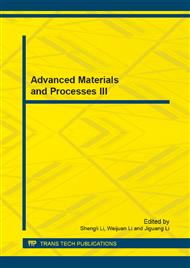[1]
S.F. Krar, M. Rapisarda, and A.F. Check. Machine Tool and Manufacturing Technology, New York: Delmar-ITP, (1998).
Google Scholar
[2]
P.S. Sreejith and B.K.A. Ngoi, Dry machining: machining of the future, J Mater Process Tech.; Vol. 101 (2000), no. 1-3, p.287.
DOI: 10.1016/s0924-0136(00)00445-3
Google Scholar
[3]
A.E. Diniz, and R. Micaroni. Cutting conditions for finish turning process aiming: the use of dry cutting, Int. J Mach Tool Manu; Vol. 42 (2002), no. 8, p.899.
DOI: 10.1016/s0890-6955(02)00028-7
Google Scholar
[4]
B. Ozcelik, E. Kuram, M.H. Cetin and E. Demirbas. Expeimental investigations of vegetable based cutting fluids with extreme pressure during turning of AISI 304L, Tribol Int; Vol. 44 (2011), p.1864.
DOI: 10.1016/j.triboint.2011.07.012
Google Scholar
[5]
A.S. Varadarajan, P. K Phillip, and B. Ramamoorthy. Investigations on hard turning with minimal cutting fluid application (HTMF) and its comparison with dry and wet turning, Int J Mach Tool Manu; Vol. 42 (2002), no. 2, pp.193-200.
DOI: 10.1016/s0890-6955(01)00119-5
Google Scholar
[6]
G. List, M. Nouari, D. Géhin, S. Gomez, J.P. Manaud, Y. L. Petitcorps, and F. Girot. Wear behaviour of cemented carbide tools in dry machining of aluminium alloy, Wear; Vol. 259 (2005), p.1177.
DOI: 10.1016/j.wear.2005.02.056
Google Scholar
[7]
A. Attanasio, M. Gelfi, C. Giardini and C. Remino. Minimal quantity lubrication in turning: effect on tool wear, Wear; Vol. 260 (2006), p.333.
DOI: 10.1016/j.wear.2005.04.024
Google Scholar
[8]
M.Y. Noordin, V.C. Venkatesh and S. Sharif. Dry turning of tempered martensitic stainless tool steel using coded cermet and coated carbide tools, J Mater Process Tech; Vol. 185 (2007), p.83.
DOI: 10.1016/j.jmatprotec.2006.03.137
Google Scholar
[9]
R.A. Mahdavinejad and H. Sharifi Bidgoli, Optimization of surface roughness parameters in dry turning, J AMME; Vol. 37 (2009), p.571.
Google Scholar
[10]
M. Nalbant, H. Gökkaya and G. Sur. Application of Taguchi method in the optimization of cutting parameters for surface roughness in turning, Mater Design; Vol. 28 (2007), no. 4, p.1379.
DOI: 10.1016/j.matdes.2006.01.008
Google Scholar
[11]
W.H. Yang and Y.S. Tarng Design optimization of cutting parameters for turning operations based on the Taguchi method, J Mater Process Tech; Vol. 84 (1998), p.122.
DOI: 10.1016/s0924-0136(98)00079-x
Google Scholar


